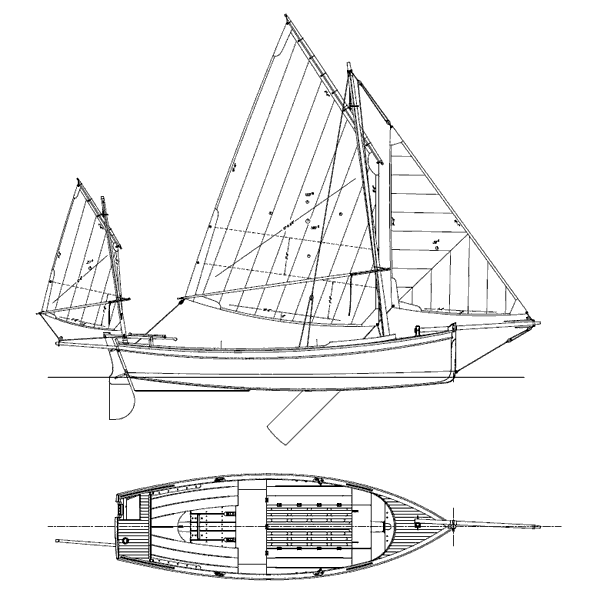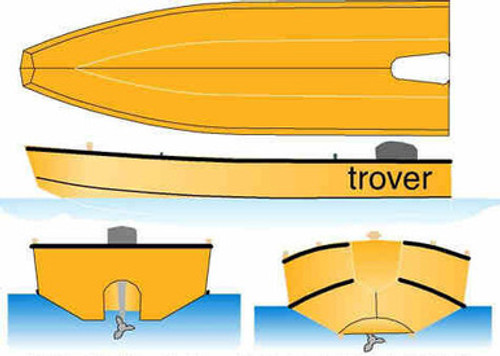for printed plans - click HERE
download free study plans HERE
MYST:
Building plans consist of 27 pages of written text and 11 sheets of computer-generated drawings, including full-size patterns for all major structural components (moulds, frames, floors, foils, hardware, etc.). This makes transferring the lines directly to the building materials a straight forward and easy task, saving the builder considerable time and effort during the construction process and greatly minimizing the possibilities of error.
Drawing #1403 (included with the study plans) shows details of the construction jig and also provides small scale patterns for making a flotation model. This may be useful for the first-time builder and can aid in understanding how the boat is to be put together, without first incurring the expense of building a full-sized hull. This model can be as simple or as complex as desired.
The design brief for Myst called for a moderately narrow hull, with an emphasis on good performance under sail throughout a wide range of weather conditions that might be encountered during coastal passages on the North American Great Lakes and along the Atlantic Seaboard. Extreme shoal draft was also desired, so that the boat could be easily trailed and launched off the beach in areas with very shallow water. Hence the need for some ballast to help the hull stand up to the generous sail plan. There is also considerable tumblehome designed into the hull to capitalize on a greater waterline beam and the higher initial form stability that it affords.

Any qualms about carrying ballast in an open boat are addressed by built-in buoyancy tanks to provide sufficient flotation to keep the boat afloat in the event of a capsize. This, coupled with the extra flotation provided by waterproof storage bags, should give the crew considerable peace of mind out on the water.
The lug yawl rig was chosen because of its inherent ability to adapt to variable wind conditions quickly and efficiently. In a squall, sail area can be dramatically reduced by simply dropping the main and carrying on under jib and mizzen. Alternatively, the boat can just as easily be sailed under main alone. Either combination will balance. The centre of effort of the sails in any one of these configurations will fall on the same vertical plane as that of the boat under full sail.
Hard on the wind, the hull can be balanced by trimming the mizzen - in effect, using it as a steering sail. The big centreboard also has a wide range of travel and can be adjusted to help balance the hull. Playing both in combination can trim out the helm and induce some degree of self-steering on most points of sail. All the running rigging can be led aft to the helm for single handing.
Inside, the layout is designed in such a way that all the cruising gear can be stowed beneath the thwarts, leaving the area above free of clutter. The central thwart area can be closed off with hinged side benches to provide a sleeping platform large enough for two people to rest on comfortably. This doubles as a deck underway and makes it very easy for the crew to move about the boat without worrying about treading on equipment and supplies stowed below.
Stripped of sail, the masts can be used to support a full-length boom tent over the living area. The tent can be arranged so that it overlaps the coamings and any rainwater would then be deflected over the side, keeping the interior snug and dry. Another option would be to simply set up a regular, free standing, dome tent on the sleeping platform. This would have the advantage of providing better protection for the crew in areas where insects are a problem. It would also save on the expense of a much larger, custom-made boom tent and could be used ashore, if desired.
Many other features have been borrowed from the very successful 18' beach cruiser Alaska design, including the wide, plank keel for ease of beaching, and the two point, endless-loop anchoring system that makes mooring and handling the boat from shore an easy job.
There is provision for an auxiliary outboard motor to be mounted on the transom. Long shaft models up to 5 HP can fitted, though a 2 or 3 HP engine is more than adequate to drive the hull at speed. For those who dislike motors, a pair of well balanced 10' oars have been designed to move the boat along nicely in light conditions.
Construction is epoxy-glued, strip-planking over laminated frames and longitudinals. Planking is 5/8" x 1" wooden strips - sealed, inside and out, with epoxy resin. Exterior fiberglass sheathing is optional, but not required structurally. This boat is intended to be economical and straight forward to build by an amateur possessing reasonably good woodworking skills. A detailed 35-page building text is included with the plans. It is highly recommended that this be further supplemented with the Gougeon Brother's book on Boat Construction for those with little experience using epoxies or building boats.
Please note: At this time, plans are only available in Imperial Measurement (feet and inches).
An excellent thread by Kent Tyson on building a Myst, including many detailed photos, can be found at this link on the Woodenboat Forum - Building / Repair:







